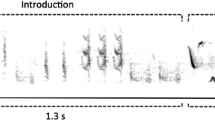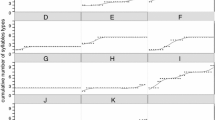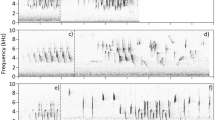Abstract
Studies of the role of bird song in avian communication have revealed numerous functions across many species, including its critical importance in female mate choice (intersexual selection) and male-male competition (intrasexual selection). A first step in understanding the role of song in different contexts is to describe the note, syllable, and song-types that occur, as well as their patterns of production within a population. Here, we do so for a north-central Illinois, USA, population of Northern House Wrens (Troglodytes aedon). As has been described in other populations, most songs (≈ 1–3 s in duration) contain an introductory section of soft, broadband notes followed by a terminal section of loud, frequency-modulated syllables that tend to be trilled. In characterizing the contents of 3.919 songs produced by 32 males throughout the breeding season, we identified 62 distinct notes, from which 76 syllables were produced. These syllables were organized in patterns largely unique to the individual—most notes and syllables were shared across the population, but almost no song-types were produced by more than one male. Singing declined over the course of the nesting cycle, and throughout the breeding season. Song production was at its minimum while fertile females were egg-laying, suggesting that males may change singing behaviour to guard against extra-pair copulations, which tend to occur at this time.
Zusammenfassung
Gesangsstruktur männlicher Hauszaunkönige und Muster der Gesangsproduktion und-wiedergabe während der Brutzeit.
Untersuchungen zur Rolle des Gesangs in der Kommunikation von Vögeln haben zahlreiche Funktionen bei vielen Arten aufgezeigt, von denen eine von entscheidender Bedeutung für die Partnerwahl von Weibchen (intersexuelle Selektion) und den Wettbewerb zwischen Männchen und Weibchen (intrasexuelle Selektion) ist. Ein erster Schritt zum Verständnis der Rolle des Gesangs in den unterschiedlichen Lebenssituationen ist die Beschreibung der vorkommenden Noten-, Silben- und Liedtypen und deren Entstehungsweisen innerhalb einer Population. Das unternahmen wir in dieser Studie für eine Population des Hauszaunkönigs (Troglodytes aedon) in Nord-Illinois, USA. Wie für andere Populationen schon beschrieben wurde, enthalten die meisten Lieder (≈ 1–3 Sekunden Dauer) einen einleitenden Abschnitt mit weichen, breitbandigen Tönen, gefolgt von einem abschließenden Abschnitt mit lauten, frequenzmodulierten Silben, die in der Regel als Triller gesungen werden. Bei der Analyse des Inhalts von 3.919 Gesängen, die von 32 Männchen während der Brutsaison produziert wurden, identifizierten wir 62 unterschiedliche Töne, aus denen 76 Silben gebildet wurden. Obwohl die meisten Noten und Silben in der ganzen Population vorkamen, war die Zusammensetzung der Silben für Einzeltiere typisch, und so gut wie kein Liedtyp wurde von mehr als einem Männchen produziert. Der Gesang nahm im Laufe des Nistzyklus und während der gesamten Brutsaison ab. Am schwächsten war die Gesangsproduktion während die Weibchen Eier legten, was darauf schließen lässt, dass die Männchen ihr Gesangsverhalten ändern als Schutz vor Kopulationen mit anderen Partnern, was in dieser Phase häufig vorkommt.







Similar content being viewed by others
Data availability
The sound recordings are available at https://doi.org/10.7479/z1sj-5p94. Electronic supplementary information contributing to this article is available online. Data, code, and materials for this study are in Zenodo at https://doi.org/10.5281/zenodo.8078003.
References
Auguie B (2013) gridExtra: Miscellaneous Functions for “Grid” Graphics
Baker MC, Cunningham MA (1985) The biology of bird-song dialects. Behav Brain Sci 8:85–100. https://doi.org/10.1017/S0140525X00019750
Bates D, Mächler M, Bolker BM, Walker SC (2015) Fitting linear mixed-effects models using lme4. J Stat Softw 67:1–48. https://doi.org/10.18637/jss.v067.i01
Benedict L, Warning N (2017) Rock wrens preferentially use song types that improve long distance signal transmission during natural singing bouts. J Avian Biol 48:1254–1262. https://doi.org/10.1111/jav.01357
Borror DJ (1964) Songs of the thrushes (Turdidae), wrens (Troglodytidae), and mockingbirds (Mimidae) of eastern North America. Ohio J Sci 64:195–207
Bowers EK, Sakaluk SK, Thompson CF (2012) Experimentally increased egg production constrains future reproduction of female house wrens. Anim Behav 83:495–500. https://doi.org/10.1016/j.anbehav.2011.11.026
Brumfield RT, Capparella AP (1996) Genetic differentiation and taxonomy in the house wren species group. Condor 98:547–556. https://doi.org/10.2307/1369567
Brylawski AMZ, Whittingham LA (2004) An experimental study of mate guarding and paternity in house wrens. Anim Behav 68:1417–1424. https://doi.org/10.1016/j.anbehav.2004.02.016
Byers BE, Kroodsma DE (2009) Female mate choice and songbird song repertoires. Anim Behav 77:13–22. https://doi.org/10.1016/j.anbehav.2008.10.003
Catchpole CK, Slater PJB (2008) Bird Song: Biological Themes and Variations, 2nd edn. Cambridge University Press, New York, NY
Cramer ERA (2013a) Vocal deviation and trill consistency do not affect male response to playback in house wrens. Behav Ecol 24:412–420. https://doi.org/10.1093/beheco/ars178
Cramer ERA (2013b) Physically challenging song traits, male quality, and reproductive success in house wrens. PLoSOne 8:1–12. https://doi.org/10.1371/journal.pone.0059208
DeMory ML, Thompson CF, Sakaluk SK (2010) Male quality influences male provisioning in house wrens independent of attractiveness. Behav Ecol 21:1156–1164. https://doi.org/10.1093/beheco/arq123
dos Santos EB, Llambías PE, Rendall D (2016) The structure and organization of song in southern house wrens (Troglodytes aedon chilensis). J Ornithol 157:289–301. https://doi.org/10.1007/s10336-015-1277-3
dos Santos EB, Llambías PE, Rendall D (2018) Male song diversity and its relation to breeding success in southern house wrens Troglodytes aedon chilensis. J Avian Biol 49:1–11. https://doi.org/10.1111/jav.01606
Dowle M, Srinivasan A (2022) data. Table: Extension of `data.frame`
Drilling NE, Thompson CF (1988) Natal and breeding dispersal in house wrens (Troglodytes aedon). Auk 105:480–491. https://doi.org/10.1093/auk/105.3.480
Eckerle KP, Thompson CF (2006) Mate choice in house wrens: nest cavities trump male characteristics. Behaviour 143:253–271. https://doi.org/10.1163/156853906775900694
Fabrigar LR, Wegener DT (2011) Exploratory factor analysis. Oxford University Press, Oxford
Finke MA, Milinkovich DJ, Thompson CF (1987) Evolution of clutch size: an experimental test in the house wren (Troglodytes aedon). J Anim Ecol 56:99. https://doi.org/10.2307/4802
Fried EI (2017) What are psychological constructs? On the nature and statistical modelling of emotions, intelligence, personality traits and mental disorders. Health Psychol Rev 11:130–134. https://doi.org/10.1080/17437199.2017.1306718
Gontard-Danek MC, Møller AP (1999) The strength of sexual selection: a metaanalysis of bird studies. Behav Ecol 10:476–486. https://doi.org/10.1093/beheco/10.5.476
Grabarczyk EE, Gill SA (2020) Anthropogenic noise masking diminishes house wren (Troglodytes aedon) song transmission in urban natural areas. Bioacoustics 29:518–532. https://doi.org/10.1080/09524622.2019.1621209
Grabarczyk EE, Pipkin MA, Vonhof MJ, Gill SA (2018) When to change your tune? Unpaired and paired male house wrens respond differently to anthropogenic noise. J Ecoacoustics 2:1–1. https://doi.org/10.22261/jea.lhgrvc
Grabarczyk EE, Araya-Salas M, Vonhof MJ, Gill SA (2020) Anthropogenic noise affects female, not male house wren response to change in signaling network. Ethology 126:1069–1078. https://doi.org/10.1111/eth.13085
Grana SC, Sakaluk SK, Bowden RM et al (2012) Reproductive allocation in female house wrens is not influenced by experimentally altered male attractiveness. Behav Ecol Sociobiol 66:1247–1258. https://doi.org/10.1007/s00265-012-1378-4
Hodges CJ, Bowers EK, Thompson CF, Sakaluk SK (2015) Cascading costs of reproduction in female house wrens induced to lay larger clutches. J Evol Biol 28:1383–1393. https://doi.org/10.1111/jeb.12662
Hothorn T, Bretz F, Westfall P (2008) Simultaneous inference in general parametric models. Biometrical J 50:346–363. https://doi.org/10.1002/bimj.200810425
Irwin DE (2000) Song variation in an avian ring species. Evolution 54:998–1010. https://doi.org/10.1111/j.0014-3820.2000.tb00099.x
Irwin DE, Irwin JH, Price TD (2001) Ring species as bridges between microevolution and speciation. In: Hendry AP, Kinnison MT (eds) Contemporary issues in genetics and evolution: microevolution rate, pattern, process. Springer, Dordrecht, pp 223–243
Johnson LS, Kermott LH (1989) Territorial intrusions in the house wren Troglodytes aedon: evidence for the sperm competition hypothesis. Ornis Scand 20:89–92
Johnson LS, Kermott LH (1990) Structure and context of female song in a North-temperate population of house wrens. J Field Ornithol 61:273–376
Johnson LS, Searcy WA (1996) Female attraction to male song in house wrens (Troglodytes aedon). Behaviour 133:357–366. https://doi.org/10.1163/156853996X00495
Johnson LS (2014) House wren (Troglodytes aedon). In: Poole A (ed) The Birds of North America, 2nd edn. Cornell Lab of Ornithology and American Ornithologists’ Union, Ithaca, NY
Kaluthota CD, Brinkman BE, dos Santos EB, Rendall D (2016) Transcontinental latitudinal variation in song performance and complexity in house wrens (Troglodytes aedon). Proc R Soc B Biol Sci 283:20152765. https://doi.org/10.1098/rspb.2015.2765
Kaluthota CD, Logue DM, Rendall D (2020) Conventional and network analyses of song organization and complexity in northern house wrens (Troglodytes aedon parkmanii). J Field Ornithol 91:375–392. https://doi.org/10.1111/jofo.12347
Kendeigh SC (1941) Territorial and mating behavior of the house wren. Illinois Biol Monogr 18:1–120
Kermott LH, Johnson LS (1991) The functions of song in male house wrens (Troglodytes aedon). Behaviour 116:190–209. https://doi.org/10.1163/156853991X00030
Krieg CA, Getty T (2016) Not just for males: females use song against male and female rivals in a temperate zone songbird. Anim Behav 113:39–47. https://doi.org/10.1016/J.ANBEHAV.2015.12.019
Kroodsma DE (1973) Coexistence of Bewick’s wrens and house wrens in Oregon. Auk 90:341–352
Kroodsma DE (1977) Correlates of song organization among North American wrens. Am Nat 111:995–1008. https://doi.org/10.1086/283228
Kroodsma DE, Byers BE (1991) The function(s) of bird song. Am Zool 328:318–328
Kunc HP, Amrhein V, Naguib M (2007) Vocal interactions in common nightingales (Luscinia megarhynchos): males take it easy after pairing. Behav Ecol Sociobiol 61:557–563. https://doi.org/10.1007/s00265-006-0284-z
Lattin C, Ritchison G (2009) Intra- and intersexual functions of singing by male blue grosbeaks: the role of within-song variation. Wilson J Ornithol 121:714–721. https://doi.org/10.1676/09-026.1
Lenth RV (2023) emmeans: Estimated Marginal Means, aka Least-Squares Means
K. Lisa Yang Center for Conservation Bioacoustics at the Cornell Lab of Ornithology (2022) Raven Pro: Interactive Sound Analysis Software
Loning H, Verkade L, Griffith SC et al (2023) The social role of song in wild zebra finches. Curr Biol 33:1–9. https://doi.org/10.1016/j.cub.2022.11.047
Mahto A (2019) splitstackshape: Stack and Reshape Datasets After Splitting Concatenated Values
Marler P, Slabbekoorn H (eds) (2004) Nature’s Music: The Science of Birdsong. Elsevier Academic Press, San Diego, CA
Marler P, Tamura M (1962) Song “dialects” in three populations of white-crowned sparrows. Condor 64:368–377. https://doi.org/10.2307/1365545
Marshall RC, Leisler B, Catchpole CK, Schwabl H (2005) Male song quality affects circulating but not yolk steroid concentrations in female canaries (Serinus canaria). J Exp Biol 208:4593–4598. https://doi.org/10.1242/jeb.01949
Marten K, Marler P (1977) Sound transmission and its significance for animal vocalization. Behav Ecol Sociobiol 2:271–290. https://doi.org/10.1007/BF00299740
Nolan VJ (1978) The ecology and behavior of the prairie warbler Dendroica discolor. Ornithol Monogr. https://doi.org/10.2307/40166732
Patten MA, Pruett CL (2009) The song sparrow, Melospiza melodia, as a ring species: patterns of geographic variation, a revision of subspecies, and implications for speciation. Syst Biodivers 7:33–62. https://doi.org/10.1017/S1477200008002867
Patten MA, Rotenberry JT, Zuk M (2004) Habitat selection, acoustic adaptation, and the evolution of reproductive isolation. Evolution 58:2144–2155. https://doi.org/10.1111/j.0014-3820.2004.tb01593.x
Platt ME, Ficken MS (1987) The organization of singing in house wrens. J Field Ornithol 58:190–197
Podos J, Warren PS (2007) The evolution of geographic variation in birdsong. Adv Study Behav 37:403–458. https://doi.org/10.1016/S0065-3454(07)37009-5
Podos J, Huber SK, Taft B (2004) Bird song: the interface of evolution and mechanism. Annu Rev Ecol Evol Syst 35:55–87. https://doi.org/10.1146/annurev.ecolsys.35.021103.105719
Prior NH, Fernandez MSA, Soula HA, Vignal C (2019) Water restriction influences intra-pair vocal behavior and the acoustic structure of vocalisations in the opportunistically breeding zebra finch (Taeniopygia guttata). Behav Processes 162:147–156. https://doi.org/10.1016/j.beproc.2019.02.007
R Core Team (2022) R: A language and environment for statistical computing
Rendall D, Kaluthota CD (2013) Song organization and variability in northern house wrens (Troglodytes aedon parkmanii) in western Canada. Auk 130:617–628. https://doi.org/10.1525/auk.2013.13069
Revelle W (2022) psych: Procedures for Psychological, Psychometric, and Personality Research
Rhemtulla M (2020) Worse than measurement error: consequences of inappropriate latent variable measurement models. Psychol Methods 25:30–45. https://doi.org/10.1037/met0000220.supp
Sakaluk JK, Short SD (2017) A methodological review of exploratory factor analysis in sexuality research: used practices, best practices, and data analysis resources. J Sex Res 54:1–9. https://doi.org/10.1080/00224499.2015.1137538
Searcy WA, Nowicki S, Hughes M (1997) The response of male and female song sparrows to geographic variation in song. Condor 99:651–657. https://doi.org/10.2307/1370477
Slabbekoorn H, Smith TB (2002) Bird song, ecology and speciation. Philos Trans R Soc B Biol Sci 357:493–503. https://doi.org/10.1098/rstb.2001.1056
Soma MF, Garamszegi LZ (2011) Rethinking birdsong evolution: meta-analysis of the relationship between song complexity and reproductive success. Behav Ecol 22:363–371. https://doi.org/10.1093/beheco/arq219
Sosa-López JR, Mennill DJ (2014a) Continent-wide patterns of divergence in acoustic and morphological traits in the house wren species complex. Auk 131:41–54. https://doi.org/10.1642/AUK-13-161.1
Sosa-López JR, Mennill DJ (2014b) Vocal behaviour of the island-endemic Cozumel wren (Troglodytes aedon beani): song structure, repertoires, and song sharing. J Ornithol 155:337–346. https://doi.org/10.1007/s10336-013-1008-6
Sosa-López JR, Mennill DJ (2014c) The vocal behavior of the brown-throated wren (Troglodytes brunneicollis): song structure, repertoires, sharing, syntax, and diel variation. J Ornithol 155:435–446. https://doi.org/10.1007/s10336-013-1024-6
Soukup SS, Thompson CF (1998) Social mating system and reproductive success in house wrens. Behav Ecol 9:43–48. https://doi.org/10.1093/beheco/9.1.43
Tove MH (1988) Patterns of singing by house wrens with respect to the breeding cycle. Utah State University
Tubaro PL (1990) Song description of the house wren (Troglodytes aedon) in two populations of eastern Argentina, and some indirect evidences of imitative vocal learning. El Hornero 13:111–116
Wickham H (2016) ggplot2: Elegant Graphics for data analysis. Springer International Publishing, Cham
Wickham H, Averick M, Bryan J et al (2019) Welcome to the Tidyverse. J Open Source Softw 4:1686. https://doi.org/10.21105/joss.01686
Ziolkowski DJ, Johnson LS, Hannam KM, Searcy WA (1997) Coordination of female nest attentiveness with male song output in the cavity-nesting house wren Troglodytes aedon. J Avian Biol 28:9–14. https://doi.org/10.2307/3677088
Acknowledgements
Thank you to the 2018 Wren Crew, in particular Kara Hodges, Dylan Poorboy, and Christine Poppe, for their contributions to recording song and capturing birds. We also thank the ParkLands Foundation (Merwin Nature Preserve) and the Sears and Butler families for allowing us to conduct our research on their land. We are grateful to Kyle Funk and John Sakaluk for providing code and expertise in R, and to Ben Sadd for discussions on statistical analyses.
Funding
Funding was provided by the National Institutes of Health (2R15HD076308), American Ornithological Society, Wilson Ornithological Society, Animal Behavior Society, Illinois Ornithological Society, Beta Lambda chapter of the Phi Sigma Society, Champaign County Audubon Society, and Illinois State University Dissertation Completion Grant, Faculty Research Award, Robert H. Gray Biology/Ecology Scholarship, BIRDFeeder Grant, Charlena Wallen Scholarship, and Illinois State University Foundation Bird Study and Student Fellowship Fund (4125104).
Author information
Authors and Affiliations
Contributions
Together all authors conceived the study. RAD was the primary data collector, analyser, and manuscript writer. All authors edited the manuscript.
Corresponding author
Ethics declarations
Conflict of interest
The authors declare no competing interests.
Ethical approval
This research was carried out with the approval of the Illinois State University Institutional Animal Care and Use Committee (protocols 865938, 2019-4) and the United States Geological Survey (banding permit 09211).
Additional information
Communicated by T. S. Osiejuk.
Publisher's Note
Springer Nature remains neutral with regard to jurisdictional claims in published maps and institutional affiliations.
Supplementary Information
Below is the link to the electronic supplementary material.
Rights and permissions
Springer Nature or its licensor (e.g. a society or other partner) holds exclusive rights to this article under a publishing agreement with the author(s) or other rightsholder(s); author self-archiving of the accepted manuscript version of this article is solely governed by the terms of such publishing agreement and applicable law.
About this article
Cite this article
DiSciullo, R.A., Sakaluk, S.K. & Thompson, C.F. Song structure of male Northern House Wrens and patterns of song production and delivery across the nesting cycle. J Ornithol 165, 203–216 (2024). https://doi.org/10.1007/s10336-023-02098-0
Received:
Revised:
Accepted:
Published:
Issue Date:
DOI: https://doi.org/10.1007/s10336-023-02098-0




